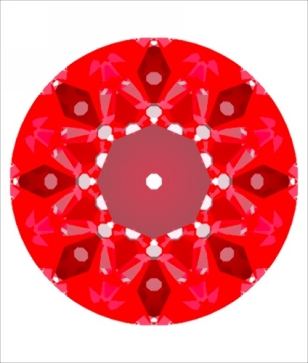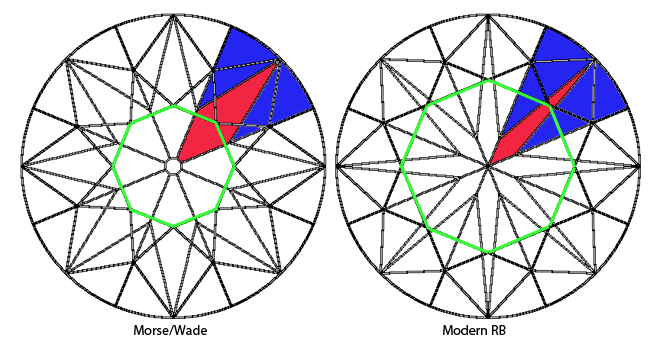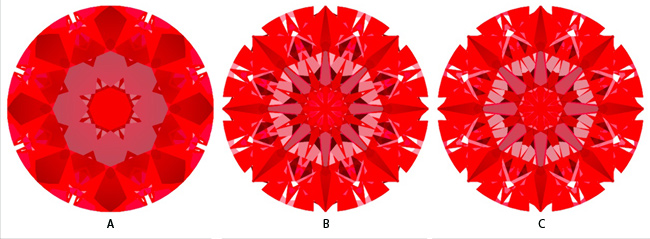How Are Diamonds Made? Natural vs Lab-Created Explained
Two Paths, One Diamond Not all diamonds come from the same place — but they all start the same way. Pure carbon, crystalized under immense pressure and heat. Whether it…
Article by Karl K.
On many websites you will see it said that the pavilion main facets drive light return. Top labs and many grading systems use the pavilion angle as a basis for assigning a cut grade. Is this correct? We will be using computer generated Ideal-Scope images created in DiamCalc for this discussion. https://www.pricescope.com/tools/ideal-scope/ https://www.pricescope.com/tools/what-is-diamond-calc/ This gives us much more freedom to experiment than using actual diamonds, allowing me to present this article. Let’s start with an explanation of the Ideal-Scope image colors. Red is light return. White is leakage. Black is a reflection of an object over the diamond, like the observer or a camera, and this is called obstruction. These colors can mix because parts of the diamond can have partial leakage/partial obstruction, resulting in pinkish or grayish areas as well as varying brightness of red.
Let’s look at a historical cut; ancestor of the modern round brilliant. Let’s start with Morse/Wade. Crown 35 table 40% and pavilion 41 degrees with a lower girdle facet % of 60%* [see notes]


There is a huge jump in light leakage between 42.24 and 42.34 degrees in pavilion angle. 42.24 with a 35 degree crown angle on the left and 42.34 with a 35 degree crown angle on the right.

Let’s use 35 degree crown angle, 56% table and 80% lower girdles (this combination, when combined with the right pavilion angle, is predicted to get the top grade in both AGS and GIA systems). Between 41.15 and 41.25 in pavilion angle there is a huge jump in leakage with a 35-degree crown angle. 41.15 with a 35-degree crown angle left and 41.25 with a 35-degree crown angle right.

The lower girdle facets angle goes from 42.24 degrees (no leakage) to 42.34 degrees (leakage), the same angles as the pavilion mains in Morse/Wade with a 35-degree crown angle.
Let’s take a modern Round Brilliant many experts would call steep deep: 41.2 degree pavilion angle and 35 degree crown angle with 80% lower girdle facet % and a 57% table. As you can see there is extensive under table leakage mixed with obstruction.


Yes.
The angle averages according to a Sarin scan are: crown 35.3 pavilion 41.6 with a 56.8% table. This combo is leaking light over the lower girdle facets and the mains are returning light. The angle of the mains is ok; it is the lower girdle facet angles that are not optimal at 42.09 to 43.34 degrees.

The exact angle at which the lower girdle facets start to leak varies with the crown angle. As thepavilion angle increasesthey will always start to leak before the pavilion mains in a modern round brilliant diamond. The evidence is clear that the lower girdle facets are driving light return much more in a modern round brilliant than in Morse/Wade. It is also clear that the pavilion mains are only part of the story when it comes to what drives a modern Round Brilliant’s light return. The inescapable conclusion is that the real limit on the pavilion to avoid leakage involves the lower girdle facets more than the pavilion mains in a modern round brilliant.
Notes:
It is possible to narrow the range where the change occurs in a smaller range but on a real diamond a 0.1 range in angles is already beyond the practical tolerances of current manufacturing (on a consistent basis) and there is a clearer jump in the wider range. With a narrower range it becomes harder to say what constitutes a large difference versus a small difference in the appearance of the images. GIA now calls the Lower Girdle Facets the Lower Half Facets. It is unknown if Morse really preferred a narrow set or a wide set of angles. We deduce that Wade credited him with 41-degree pavilion, 35-degree crown and 40% table but there is no concrete evidence of this, and the ability to measure to 1 degree increments was not commonplace until well into the 1900s.
More information on Morse/Wade can be found in Al Gilbertson’s book American Cut The First 100 years.
Thank you to Al Gilbertson for insights and details about early round brilliants.
Thank you to those that proof read and provided editorial and technical support. John Pollard, Garry Holloway, Neil Beaty.
Discuss here